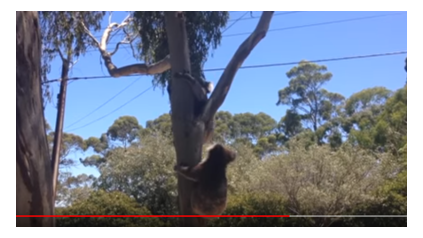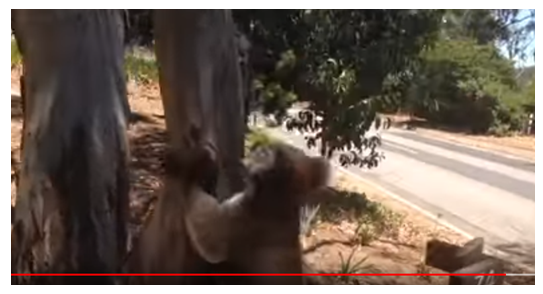-
Paper Information
- Paper Submission
-
Journal Information
- About This Journal
- Editorial Board
- Current Issue
- Archive
- Author Guidelines
- Contact Us
Research in Zoology
p-ISSN: 2325-002X e-ISSN: 2325-0038
2020; 10(1): 1-10
doi:10.5923/j.zoology.20201001.01

Koalas as Same as Apes Can Acquire Language?
Mehrnoosh Pirhayati
M.A. in English Language Translation, Department of English Language, Science and Research Branch, Islamic Azad University, Tehran, Iran
Correspondence to: Mehrnoosh Pirhayati, M.A. in English Language Translation, Department of English Language, Science and Research Branch, Islamic Azad University, Tehran, Iran.
| Email: |  |
Copyright © 2020 The Author(s). Published by Scientific & Academic Publishing.
This work is licensed under the Creative Commons Attribution International License (CC BY).
http://creativecommons.org/licenses/by/4.0/

Imagine you did not have the system of producing human language and only what you had were the numbers of one to ten. How would you thought that you might use them for communicating? one for hello? and two for bye bye? Now imagine you had only the system of songs, do, re, mi, fa, sol…So, you might probably use sol for saying hello? In here, some questions can be raised such as, does the language of animals can be assimilated to our understanding of sound ranges that human cannot comprehend them? For example, the sounds produced by ants, because what they produce are 1 kHz. How can be possible interpreting the language of them, even the ant? Does each types of animals have a particular recognizable culture which their languages, like human being were originated from it? Does this culture has overlaps with human’s culture? - Does understanding their language can lead to appropriately employing them in human’s life, instead of to working robots? Imagine you be able to talk with an animal by meaningfully using its language and telling him/her to do something for you and instead of psychologically accustoming them to work like this. That is the structure of this research to shed the lights on the language of non-human beings specially koalas, to probably kick the door of more investigation about them and make their lives easy in this modern world.
Keywords: Animals, Communicative signals, Koala, Learning language, Non-human language
Cite this paper: Mehrnoosh Pirhayati, Koalas as Same as Apes Can Acquire Language?, Research in Zoology , Vol. 10 No. 1, 2020, pp. 1-10. doi: 10.5923/j.zoology.20201001.01.
Article Outline
1. Introduction
- By separating the species of human being, still can be seen that natural world contains different other species including dogs, birds, bears, etc. As can be observed, some animals that belong to different particular species can live individually, or as a group can live together. Everybody may have captured the scene of animals’ fighting – from one or two different species, or their unification in hunting as, a joint effort. It is obvious that, they without having the system of human language can communicate with each other. As Yule [1] stated, bee with limited system of producing signals, by different kinds of dancing, can communicate with other bees. This range can be extended to the ability of chimpanzee in learning sign language, like Washoe, the female chimpanzee who learned 350 sings of American sign language. On the other hand, human’s ability of learning language does not depend on its gene, like having brown eyes, yellow hairs, etc. Instead, it acquires language within a particular socio-cultural context in its relationship with other humans. That’s why Korean infant who is born in the United States of America can be native in American language [1]. Human and animal both live in context, and make different and various relationships with the other members of its or the other species. Sekhar Dash and Bhattacharyya [2], described Animal Communication System (ANICOMS) as the methods, ways, and models that a particular animal uses in communicating with the species that is considered as same as it or using for communicating with other species, like human, and also the study of ANICOMS that is known as Zoosemotics, with the aims of revealing particular inter and intra -communication patterns, and animals’ meta-communications [2]. Generally, animals’ communication can be appeared as what is brought in bellow:• physically; through distinctive body parts,• body movement,• vocal communication • olfactory communication • electro-communication [2, p. 14].He bolded two aspects that must be payed enough attention including, 1- the identification of selective pressures that provide suitable condition(s) for animal to develop its communication ability, and also 2- the identification of what that can be considered as the lacked features or behaviors that animal can learn it. So, the number three can be added to these points as, the identification of process/es that the animal gets the impact due to the normal environment and conditions as, feeling a sort of normality or desire by which without bearing any pressure tries to make communication and continue its relationship, like when a dog makes special relationship with its owner by producing particular sounds and doing specific routine actions as showing its happiness. Based on Smith [3], the three levels must be taken into consideration by the scholars including, syntactic level that contains signals, like vision, scent markings, and hearings and he divided the signals into two different types of 1- discrete signals, and 2- graded signals, semantic level that is defined as the meaning and information that a particular signal contains. It was divided into two different types as 1- behavioral message that was described as its indications to what message that evolutionary was selected like attack, escape, or run, and how message that works as the supplementary and can show intensity, probability, directionality, etc., and 2- non-behavioral message that indicate to who message as what that point at the communicator like its sex, species, etc., and where message that shows the location of the producer or sender, and pragmatic level that shows the specific work of signal like it was produced to make threat, to warn, or to copulate. Sekhar Dash and Bhattacharyya [2] bolded two types of interspecies communication as prey to predator pattern which its other name was brought as interceptive eavesdropping. However, some invariable communications of prey to predator cannot be named as interceptive eavesdropping like, warning coloration of some animals like wasps that acts as the modification of behavior of predator in such a way that, it instinctively, or as the result of its experience, avoid attacking it and pursuit-deterrent signal that can be comprehended as advertising the capacity of prey to scape in two aspects via phenotypic condition as quality advertisement which produces the 2- perception advertisement as the prey is detecting the predator. Predator to prey communication is happened to change the behavior of prey to deceive it and better catch it. Sekhar Dash and Bhattacharyya [2] further explained that, animals may not have human language communication system but, they send their desires, needs, and reactions through their sophisticated signaling systems of their own. Hockett [4, pp. 89-97]; Hockett and Altmann [5, pp. 61-72] enumerated these four features that distinguished language system of human being from other species, 1- duality of patterning or double articulation, 2- prevarication, 3-reflexiveness (meta linguistic function of language), 4- learnability (learning and using more than one language) with mentioning that these four are completely unique as the properties of human’s language system. The other features can be added to these four elements as, the ability of human in creating language at the both levels of lexis and syntax; by using a few fundamental laws of construction can produce a large number of meaningful and complete structures, the recursiveness of human as the ability of forming a sentence inside the other sentence without any limitation in length of the sentence, arbitrariness of human language as, the opposite of other species that are completely iconic and no signal can be broken in such a way that each part or signal separately presents a particular meaning or sense, redundancy and using ellipse, culture preserving/ culture transmitting by human language as the opposite of sheer genetic inheritance or instinctively learning, and dynamicity of human language as it is changeable by the time, and space from the level of sound, meaning, sentence, idioms, to the level of discourse, and as the opposite of spatiotemporal stativity of other species [2]. So what can be named in here, the languages of non-human species that are used for their communication in comparison with the language of human, is de-language [2]. It can be comprehended that the overlaps and differences of these terms, language, speaking, and communicating have not been clearly pointed at by defining each of them. So, it brings the researcher to generally numerate the properties of human and other species in language as what exhibited in the form of this following table:
|
2. Literature Review
- Birchenall [6] through establishing a study compared the ontogeny and phylogeny features of language to evaluate the capacities of human and non-human species. By his comparisons, the difference of human with other non-human primates (NHPs) was bolded via bringing this point, Planum Temporale (PT) within the wrenicke’s area that engages in the process of non-linguistic voices, only in human-species also is sensitive to linguistic voices that can be found in the speech of human species. According to Geschwind and Levitsky [1968, as cited by Gage & Baars, 7] the asymmetrical prevalence form of PT, the location of it in auditory areas, and its closeness to Wernicke’s area that is responsible for speech comprehension, grow this hypothesis that this part is the site for language processing. But, Neuroimaging researches responded to the role of PT in different classes of speech and non-speech sounds. Hickok [2009, as cited by Gage & Baars, 7] stated that, PT deals with so many classes of sounds for different varieties of tasks. Gage and Baars [7] explained that within the cytoarchitectural structure of PT, four distinct and different fields can be seen and each of them seems to correspond to different function of this area and so, this evidence can response to this question of why PT is activated for a wide variety of tasks and stimulus types, in so many neuroimaging investigations. Other scholars such as, Geschwind [8]; Wise et al. [9]; Karbe et al. [10]; Moffat et al. [11]; Nakada et al. [12]; Foundas et al. [13]; and Campbell et al. [14] also stated that, although a system of areas within the temporal cortex are important for the perception and comprehension of speech, particularly phonological processing is associated with the cortex of PT and inferior parietal lobe. This point sparks this question of so, what animals do with this part of non-human primate’s area of language (PT)? [15;16]. These bellow figures can be helpful for more clarifications:
 | Figure 1. Broca’s area and Wernicke’s area in human’s brain (upper), and Chimpanzee’s Brain (lower) [17] |
 | Figure 2. Koala’s brain [18] |
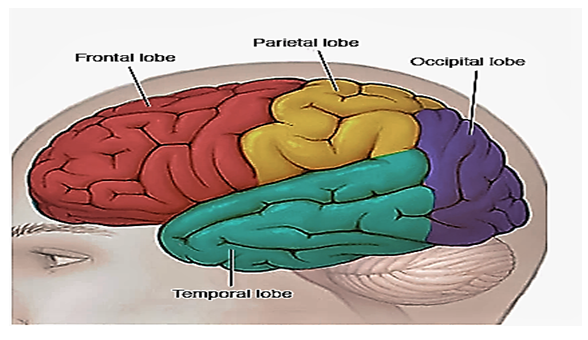 | Figure 3. The location of lobes of human’s brain [19] |
 | Figure 4. Motors and sensory regions of cerebral cortex [20] |
3. Methodology
- This study in its nature can be considered as a descriptive-explanatory, and interpretive research which benefited from the qualitative approach. This research constructed based on regarding continuity approach towards language. The study was conducted in order to answer the questions raised in the section of introduction. The researcher regarded koalas as a good case for her study, and so, this research is limited to studying Koalas’ behaviors; observing the ways of koala’s making relationship with each other, specially, in fighting. Because of the limitation of distance, the researcher used the recorded documents including photos and videos taken from YouTube (www.youtube.com).
4. Reports
- Following the observation of koala’s relationship with human, they quickly can understand their helping-hand purposes of humans, and don’t get a sort of angry and violent reaction in facing its non-species and try to be the follower of human’s aim and by being obedient try to have a relationship with him [39], and even have been seen that, this animal to request water and showing its feeling of being thirsty and being heatstroke tries to being close itself to the Australian bicycle rider whom were riding his bicycle in a way near the one of the forest of Australia [40], or when a firefighter was in a trying to give some water to it from a bottle of water, the koala without showing any violent or strange feeling, while it tranquilly sat on his car, tried to simplify its drinking by using its hand, like what human does as getting it to control or work with it; trying to get the bottle of water to bring it close to its mouth by using its hand (it probably did this behavior for the first time) [41], and when they were kept in camps in order to get treatments, they showed normal behaviors in facing the staffs of camps and didn’t show any struggle or reaction, due to a feeling of forcefully being in a condition of making relationship with its non-species, and after a while, the camp and its conditions got the form of being regarded as the new home of koala, where it can normally live in it, by its normal acceptance [42]. Similarly, a koala that caused people to get stuck in traffic on a highway in Australia, without feeling of being feared by its non-species as facing the strangers and must scape or leave the scene, did not leave the highway and so simply kept its going on it, and one of them with full of curiosity at a home appliances store didn’t want to leave it [43]. By Observing them during the fighting with each other to occupy a tree in a residential area, some signals as similar calls [44, sec. 0.12- 0.45], the combination of one or more than one note generated in isolation or in short bursts which can have semantic content in their own [6], were produced by one of the koalas as its trying to communicate and say something (in relation to its claim and condition) with human (without any fearing) [44]. Focally from the seconds of 0.37 to 0.45, the koala, that was fell by the other one, produced similar and frequent calls in front of the human (the woman who was filming), and then (sec. 0.46-0.55) it seems that, because of not being comprehended by the woman, the koala stops its calling and starts to turn its head around and looking around (probably to get help), and then for once again, started to get its tree from the other koala, and after falling again by it on the ground, it started producing other different similar-frequent and different calls [44, min. 1. 23-1. 33, & min. 1.34-1.44]. These bellow photos can be useful for better understanding: On the other hand, in terms of regarding the pattern of these calls, different patterns were produced by the koala, the claimer, that seems different types of communication, and different occasions caused variety of patterns to be produced by it; four clear and distinguishable different sounds/patterns in front of human (sec. 0.12-0.18, 0.20- 0.44, min. 1.34- 1.37, & 1.40-1.45; due to probably being deviated by the sound of the car that was made when it crossed the road), and five clear and distinguishable, different sounds/patterns (min. 1.07-1.08, 1.09- 1.10, 1.18-1.19, 1.21-1.22, 1.23-1.32) during facing and fighting with the other koala.
 | Figure 6 and Figure 7. Kola stops calling and starts to turn its head around (probably to get help) [44] |
 | Figure 8. Koala climbs up again to get back its tree [44, min. 1.06] |
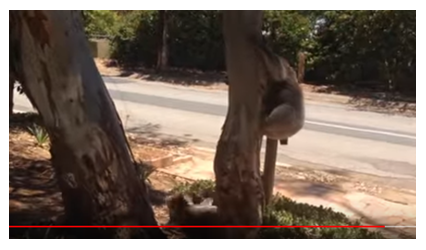 | Figure 10. Koala is fell by the other one on the ground for once again [44] |
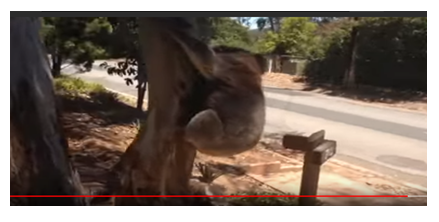 | Figure 11. Koala, the winner one, stops going down from the tree after falling the claimer on the ground for second time, and pauses on tree, while it is looking at it [44] |
 | Figure 13, and Figure 14. Koala doesn’t fight, probably since the woman comes herself close to the other one that is fell from the tree by it [44] |
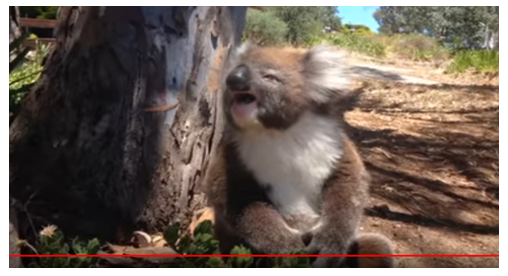 | Figure 15. The loser koala is producing similar-frequent calls [44, min. 1. 34-1.44] |
 | Figure 16. Koala Is drinking water from hosepipe while it is held by it near its mouth [45] |
 | Figure 17. Keeping on its eating food in front of human [42] |
 | Figure 18. Koala holds up traffic in highway [43] |
 | Figure 19. Koala comes close to strangers/humans [43] |
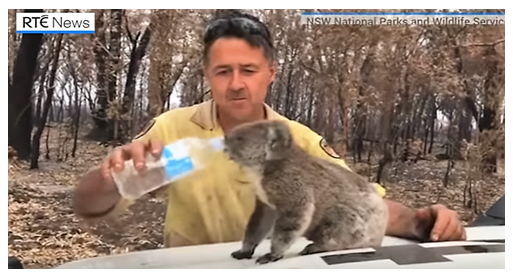 | Figure 20. Koala tranquilly seats on car [41] |
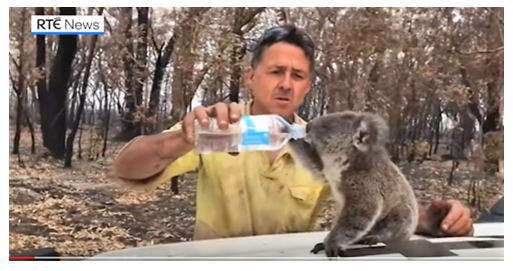 | Figure 21. Koala tries to get the bottle of water to better drink [41] |
 | Figure 22. Under the hand of doctor the koala gets checkup [42] |
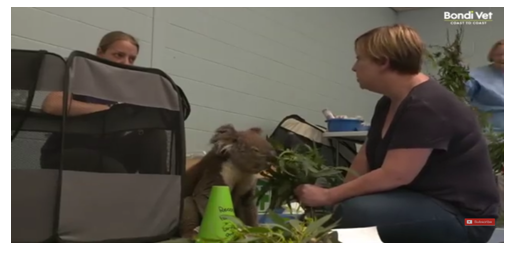 | Figure 23. Without any reaction or paying attention to strangers’ behaviors keeps on its eating [42] |
 | Figure 24. Koala gets feeding from the hand of doctor by a syringe [46] |
5. Discussion
- As the results of this study proved, some similarities exist between koala and apes as their lives can get impacts and changed by human’s life. As can be seen, such these acts, for the first time fixing hosepipe or bottle of water near the mouth to better drink, or being closed itself to human as its non-species to benefit from it, have obviously overlaps with human’s culture, and done by acculturation. In here these questions can be raised: 1- can such this animal learn more things and produces more creative works by generalization or causing by human’s paying attention to its aims and purposes as well as regarding its physical conditions, its cognitive, communicative and language abilities being grew and developed?, and 2- can it be possible, having a clear, recognizable, and common human-animal/ or koala language that can be workable for human-animal communications, like the cases of bonobos that learnt sign language and could communicate and talk to human, and can be normally translated inter-lingually or/and intra-lingually?
6. Conclusions
- Animals like human are communicative species. They often do this to benefit from others, and for particular aim, like hunting, travelling, eating food, etc. They produce signals for communication which can be regarded as particular actual behaviors, and sounds/patterns. This can be illustrated as a range from simple actions of bee, to intentional cognitive actions followed by producing sounds/patterns, like apes. As our world fast and quickly goes toward being more industrial, and modernity causes of many different manipulations and changes in our natural world, inevitably animals gets impact by human and his way of life, and also can be said that, they are not alone, and don’t live in a pure local and isolated form; when woods are broken and manipulated by paths and/or highways, and the existence of human to work in these areas. As the results of this study on koalas indicated, they didn’t being afraid from experiencing new environments, and tried to being themselves close to human in order to benefit from him. As observations proved, it seems that their actual behaviors and their sounds/patterns were changed as modification of their behaviors, and also producing new ones, that are more cognitive, intentional, indicative and directional, different, complex, and vary; like in fighting for tree in front of human, fixing hosepipe or bottle of water, going to home appliances store and curiously checking out the inside of it. From these observations, it can be concluded that they are being affected by human and like apes the have the potentiality of learning more and being more cognitive, and intentional. This study requests further studies and investigations, not limited to koalas, but all animals in order to make their lives easy in such this modern and industrial world, and also to more benefit from animal-human relationship, and their communications.
 Abstract
Abstract Reference
Reference Full-Text PDF
Full-Text PDF Full-text HTML
Full-text HTML

